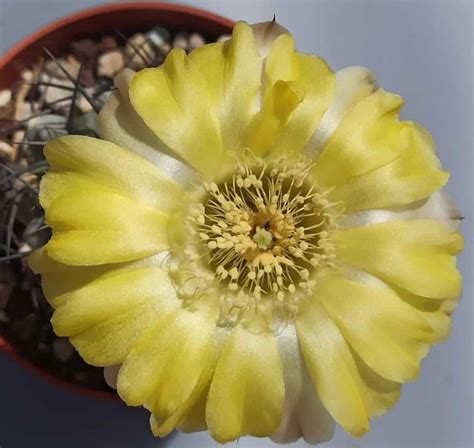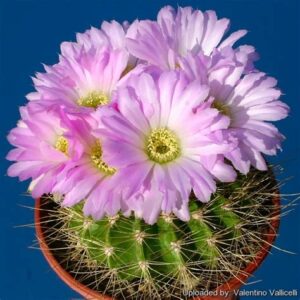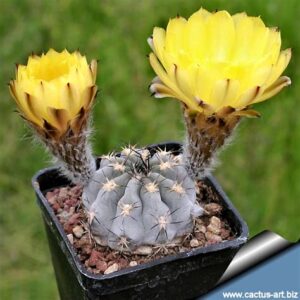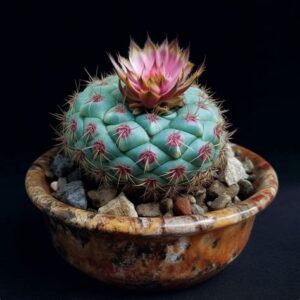The realm of cacti, with its myriad forms and vibrant colors, never ceases to invoke a sense of wonder among enthusiasts and casual observers alike. Among the multitude of species, Acanthocalycium glaucum stands out, not only for its striking physical characteristics but also for the compelling narratives tucked away in its growth and care requirements. This article delves into the captivating world of this succulent marvel, illuminating its distinctive attributes, environmental needs, and the nuances of sustaining its wellbeing.
Recognizing the Allure of Acanthocalycium Glaucum
At first glance, Acanthocalycium glaucum commands attention. Its globular body, characterized by a vivid green hue and prominent ribs, creates an appealing aesthetic that captivates collectors and horticulturists. The plant’s surface is often adorned with bristle-like spines that extend outward, lending not only an exotic texture but also an intriguing visual depth.
However, it is not just the physical attributes that draw admiration. The story of Acanthocalycium glaucum begins in its native habitat. This species is indigenous to the drier regions of South America, particularly Argentina. Here, it thrives in a landscape marked by arid conditions and intense sunlight, which profoundly influences its growth and care. Understanding these environmental factors unravels the reasons behind its fascinating adaptations.
Distinguishing Characteristics and Varietals
Acanthocalycium glaucum showcases a captivating morphologic profile that varies significantly based on the environment and subspecies cultivated. While the foundational species displays a rounded, robust form, several varietals have emerged, each with distinct traits. The color of the spines ranges from off-white to honey-brown, creating a stunning contrast against the plant’s verdant body.
One common observation among collectors is the plant’s flowering behavior. When conditions are optimal, Acanthocalycium glaucum produces flowers that bloom in shades of yellow to orange, often emerging in the summer months. These ephemeral floral displays not only enhance its visual appeal but also signify the plant’s vitality and the health of its growing conditions.
To the untrained eye, cacti may appear deceptively similar, yet the subtleties in form and color exemplify the diversity within the genus. Passionate collectors often seek specific cultivars, leading to a broader understanding of hybridization and genetic variations that contribute to the plant’s allure.
Creating the Ideal Environment
Successfully cultivating Acanthocalycium glaucum hinges on replicating the conditions it experiences in nature. This necessitates an understanding of its environmental preferences, particularly when it comes to light, soil composition, and watering regimen.
Light Requirements
A fundamental need of Acanthocalycium glaucum is ample sunlight. This cactus revels in bright, direct light, ideally receiving six to eight hours of sunshine daily. Inadequate light can lead to etiolation, where the plant stretches unnaturally in search of illumination, significantly detracting from its characteristic shape.
For indoor cultivation, utilizing south-facing windows or grow lights can effectively simulate its preferred conditions. Additionally, during the hotter months, it may thrive when periodically moved outdoors, allowing it to bask in the sun’s radiance, provided it’s gradually acclimatized to prevent sunburn.
Soil Composition
The choice of soil is equally paramount when it comes to nurturing Acanthocalycium glaucum. A well-draining soil mix fortified with ample perlite or coarse sand is ideal. This composition facilitates rapid drainage, minimizing the risk of root rot—a common affliction of cacti that stems from prolonged moisture retention.
Moreover, consider an acidic to neutral pH range for optimal health. Using a specialized cactus mix can simplify the process, though enthusiasts often prefer to curate their blends, ensuring that the ingredients align with the specific drainage needs of their plants.
Watering Practices
When it comes to watering, less is more with Acanthocalycium glaucum. This cactus thrives in arid conditions, so caution is key. It’s best to adopt a seasonal watering schedule. During the growing season (spring to summer), watering should occur more frequently but should still allow the soil to dry out completely between applications. In stark contrast, during the dormant months (fall and winter), reduce watering significantly to prevent excess moisture from fostering decay.
Observing the plant for signs of stress can alert caretakers to necessary adjustments. Yellowing or softening of the body typically indicates overwatering, whereas shriveling may suggest a need for more frequent hydration.
Nurturing Acanthocalycium Glaucum Through Nutrition
Feeding Acanthocalycium glaucum is essential to promote healthy growth and stunning flowers. A diluted liquid fertilizer designed for cacti should be applied during the growing season, approximately every four to six weeks. However, during dormancy, nutritional needs are diminished, and fertilization should cease altogether. This cycle mirrors the natural rhythm of the plant, ensuring a robust life cycle.
Potential Pests and Diseases to Watch For
Even the most diligent care cannot completely shield Acanthocalycium glaucum from pests and diseases. Mealybugs and spider mites are instances of unwelcome visitors that can jeopardize the health of the plant. Regular inspections and proactive measures can mitigate infestations before they escalate.
Additionally, ensuring optimal airflow around the plant can prevent fungal infections, which are often exacerbated by overly humid environments. If disease does strike, prompt intervention with a suitable fungicide can often save the plant.
The Fascination with Acanthocalycium Glaucum: A Deeper Reflection
What truly encapsulates the allure of Acanthocalycium glaucum is not only its beauty or unique care needs but the inherent connection cacti enthusiasts feel to nature through cultivating such specimens. These plants serve as a reminder of resilience, having adapted to harsh environments while showcasing the effortless elegance of survival.
This deep-rooted fascination extends beyond mere aesthetics. It reflects the intricate dance between nature’s elements and their ability to thrive against the odds. For many collectors, nurturing Acanthocalycium glaucum becomes a metaphor for growth and perseverance, echoing the cyclical nature of care and revitalization.
Conclusion: A Living Testament to Passion
The journey of exploring Acanthocalycium glaucum is laden with discovery and insight into the complexities of natural ecosystems. From its striking characteristics and specific care requirements to the deeper emotional bond formed through cultivation, this cactus presents a myriad of lessons. Through careful observation and adaptation, enthusiasts can continue to marvel at the beauty of Acanthocalycium glaucum, ensuring its place within gardens and homes alike for generations to come.





Leave a Comment